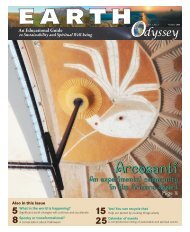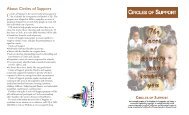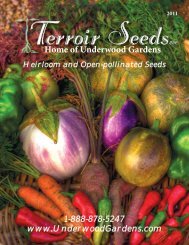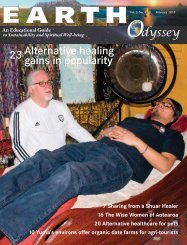Insidethisissue - aha Creative Ink
Insidethisissue - aha Creative Ink
Insidethisissue - aha Creative Ink
You also want an ePaper? Increase the reach of your titles
YUMPU automatically turns print PDFs into web optimized ePapers that Google loves.
Combining art, psychology to facilitate healing<br />
The Expressive Arts<br />
Therapy Program at<br />
Prescott College began<br />
in 2001 with two students. Now<br />
in its third year, the program has<br />
grown to 13 full-time students.<br />
The Expressive Arts<br />
Therapies Program combines<br />
the disciplines of psychology<br />
and the arts and stresses the<br />
therapeutic and healing power<br />
of art within one’s life. Art is<br />
one of the oldest forms of visual<br />
communication that supports<br />
one’s desire and right to communicate<br />
thoughts and feelings<br />
and to tell one’s story.<br />
The art therapist helps<br />
clients reconnect with their primary<br />
creativity, play with unresolved<br />
conflicts, and find new<br />
solutions and meaning to see<br />
new possibilities in one’s life.<br />
The art therapist also facilitates<br />
the development of the imagination<br />
and creativity, necessary<br />
aspects of the identity in order<br />
to reclaim a whole self.<br />
The Program trains students<br />
to become expressive art therapists<br />
and licensed counselors<br />
meeting the educational standards<br />
of the American Art<br />
Therapy Association Inc., the<br />
International Expressive Arts<br />
Therapy Association, and the<br />
state of Arizona. Through theoretical<br />
and practical experience,<br />
students acquire in-depth<br />
knowledge of human development,<br />
personality theories, and<br />
multicultural considerations, as<br />
well as gaining an understanding<br />
of applications of art within<br />
the therapeutic process.<br />
In addition to the academic<br />
coursework, students attend<br />
two Art Therapy Institutes,<br />
where they spend two weeks in<br />
classes at Prescott College<br />
working with visiting faculty<br />
who are experts in the field of<br />
expressive art therapy.<br />
These classes include handson<br />
experiences in dance, drama,<br />
writing, and visual art. Students<br />
learn how to work with clients in<br />
the therapeutic environment.<br />
Throughout the Institute, students<br />
also do their own work to<br />
cultivate an awareness of their<br />
personal creative process and<br />
provide insight into themselves<br />
so that they may work more<br />
effectively with clients.<br />
Some of the activities at the<br />
summer 2004 Institute included<br />
looking at slides of artwork<br />
to learn to “read” drawings that<br />
offered direct clues pointing<br />
toward the psychological issues<br />
that might challenge a client.<br />
After an extensive session looking<br />
at slides with facilitators,<br />
students completed their own<br />
drawings to practice reading<br />
the drawings within small<br />
teams comprised of three of<br />
their classmates.<br />
During another learning session,<br />
students wrote and illustrated<br />
fairy tales, which were<br />
ultimately dramatized in two<br />
groups. Through the dramatization<br />
of these tales, students witnessed<br />
the power of story in<br />
bridging universal themes within<br />
the arts to life.<br />
The culminating project took<br />
place on the last day of the<br />
Institute and offered one more<br />
essential connection among the<br />
group. The group prepared for<br />
the final event by making gifts<br />
for all Institute participants during<br />
the last week of the afternoon<br />
material class. These gifts<br />
were exchanged after the group<br />
made an outdoor mandala of<br />
twigs, stones, wildflowers, vines,<br />
and assorted other natural materials.<br />
The mandala provided a<br />
ceremonial space for the gift<br />
exchange, closing the experience<br />
with small tokens to take away as<br />
a symbol of the time spent<br />
together, commemorating the<br />
profound learning that occurred.<br />
Students also became aware of<br />
the healing power of the arts<br />
for the environment and the<br />
earth.<br />
The overall experience of the<br />
Institute was best summed up<br />
by one of the students in a paper<br />
reflecting upon her learning.<br />
“The Institute was professionally<br />
driven so that we could take<br />
away tangible tools and theory to<br />
utilize with our field of study,”<br />
the student wrote. “And it was<br />
experienced on an emotional<br />
level due to the investment one<br />
had to make into the process of<br />
receiving information from the<br />
presenter, and trying it out on<br />
oneself or the other group members.<br />
Additionally, it was felt on<br />
a physical level because mind<br />
and body work was incorporated<br />
into the daily partake of information.<br />
Mostly, it was a spiritual<br />
experience because the facilitatory<br />
of this whole experience<br />
had the ability to incorporate<br />
her heart into the creation of<br />
this Institute. Real connections<br />
were made, which are now slowly<br />
transforming my life at the<br />
colloquiums because that great<br />
energy is flowing over to our<br />
experiences in the workshops<br />
and seeing each other around<br />
Prescott and the school.”<br />
Fall 2004Transitions<br />
by Cappi Lang Comba<br />
and Ellen Greenblum<br />
Photo by Ellen Greenblum<br />
Shown above around the<br />
mandala made out of things<br />
from the environment for final<br />
circle and closure at the 2004<br />
Summer Art Institute are,<br />
from left, Betsy Odman, Cappi<br />
Lang Comba, Paul Comba,<br />
Trish Haskey, Kasey Grissom,<br />
JoAnn Garay, Siobhan Danreis<br />
and Ellen Jordon. The idea of<br />
the mandala is to create a<br />
group project that is<br />
restorative and healing for<br />
both the group and the<br />
environment and to make<br />
meaningful connection with<br />
each other and the<br />
environment.<br />
13







